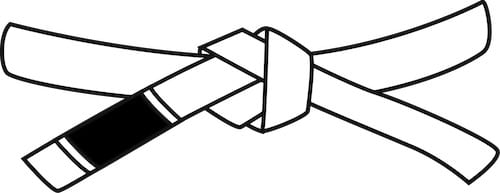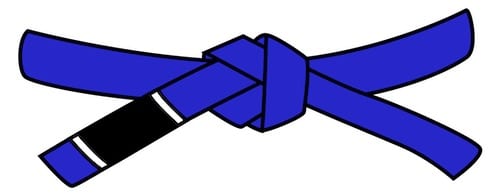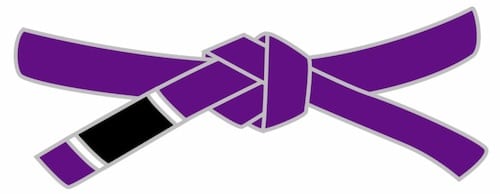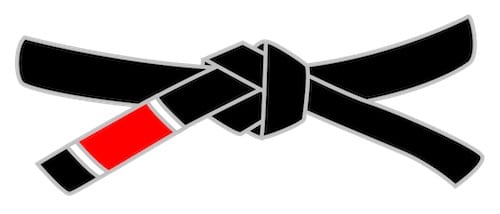
The art of Brazilian Jiu Jitsu is a fantastic martial art that provides a litany of positives to your life. Many know BJJ is a grappling based self defense system, but there’s one thing that can confuse potential students. The BJJ ranking system and jiu jitsu belt rankings.
New students usually have a lot of questions about the BJJ ranking system. Everything from what are the ranks, how long does it take to get promoted, how do I get my jiu jitsu belt promoted?
Well new students don’t have to ask anymore, because we’re going to explain the BJJ ranking system for you. We’re going to breakdown every BJJ rank for adults, and detail everything you need to know about each belt. After reading our breakdown, you will fully understand the BJJ ranks and what you need to do to get promoted.
What are the BJJ ranks?
Before we detail each belt in Jiu Jitsu, here are the ranks of BJJ for adults.
- White Belt
- Blue Belt
- Purple Belt
- Brown Belt
- Black Belts
These are the 5 colored jiu jitsu belts you progress through on your BJJ journey. White being the beginning of your journey and black belt signifying that you completed the color belts of BJJ. For the next section we will be breaking down each rank, what they signify, and how you get promoted.
Jiu Jitsu White Belt

The white belt is one of the most special belts in Jiu Jitsu. It marks the beginning of your journey into BJJ and has the potential to become a passion in your life.
At white belt, you are basically a baby. Everything is new to you and you are just trying your best to try and absorb everything you can.
What do you learn as a white belt?
As a white to get promoted to blue belt, you will be primarily working on one aspect of Jiu Jitsu. Basics.
At white belt, you spend all of your time learning the basics of the martial art. These basics are the foundations of your game that you will later develop at higher BJJ belt ranks.
What you’ll learn includes:
- BJJ Positions: guard, half guard, side control, back mount, etc.
- Basic Submissions: All of the basic submissions including, armbar, triangle, kimura, rear naked choke(RNC), guillotine choke, and americana.
- Basic Guard Passes: Basic guard passes that include traditional guard break, knee slide, double under pass, and standing pass.
- Basic Sweeps: Hip bump, scissor sweep, butterfly sweep are must know basic sweeps for white belts.
- Takedowns: Basic double leg and single leg takedowns, as well as simple Judo throws are also must know techniques.
What to expect at white belt?
As a white belt, there is one thing you need to expect and that is losing. Since you’re a beginner, you will lose and you will lose often when you roll with your more experienced teammates.
It is an important part of your progression and something that you must accept. Everyone that has gone through this phase of Jiu Jitsu lost frequently before they started winning rolls. Losing is very important as it shows you what you need to work on and it makes you better.
How long does it take to get promoted?
Generally most BJJ academies have a timetable between 100 classes to 130 classes before being promoted to blue belt. So if you train consistently, you should earn a blue belt in about a year at most Jiu Jitsu schools.
Jiu Jitsu Blue Belt

The blue belt is your first promotion in BJJ. Blue belt is the equivalent of going into your teen years. You developed a base in BJJ and now this is where you start forming an early version of your game.
What do you learn at blue belt?
At blue belt you will be learning the following:
- Continue Training The Basics: You will continue drilling the basics, while adding on to what you learned at white belt. Learning new variations of basic submissions and different ways to get them for example.
- Gi Techniques: At many BJJ schools, they put more emphasis on the use of the Gi for their blue belt students. Gi techniques that include submissions and sweeps, where you use your Gi or the opponent’s Gi.
- Learn New Guards: As a white belt, you learned basic guards and at blue belt you learn the basics of more advanced guards. Those guards will include spider guard, De La Riva, and butterfly guard.
What to expect at blue belt?
Within the BJJ ranking system, the blue belt is where most Jiu Jitsu students quit. This is because many blue belt students go through a phase that some call “the blue belt blues.”
Basically what happens is after a student gets their first colored belt, they can get a bit of an ego. They get a sense of confidence that they’re awesome at Jiu Jitsu and going to start smashing people.
But a lot of the time that doesn’t really happen. They continue to lose, when they thought they’d start beating everyone.
When they get their confidence shattered by purple and brown belts it makes a lot of them quit. It is an unfortunate reality, but if you keep yourself grounded and focus on getting better you’ll be fine.
How long does it take to get promoted?
Going from blue belt to purple belt generally takes double the amount of time than your first promotion. A year and a half to three years is the usual timeline for a student that trains consistently.
Basically double the amount of time it takes to earn your blue belt. With the prerequisite of attending at least 200+ classes and show that your abilities are up to par.
Jiu Jitsu Purple Belt

When you are a purple belt, you are right in the middle of the BJJ rankings. It is a very important belt for a number of reasons.
At this belt is when you really start to come into your own as a grappler. This is where you begin honing your BJJ game and make improvements. Black belt is just over the horizon, but you still have a few more years of work to do.
What do you learn at Purple Belt?
There are really only two things you do at purple belt, but they are extremely important. You develop your BJJ game and continue training.
- Your BJJ Game: At blue belt you have sort of a game, but not really. You have a few go to submissions and sweeps you go to, but not really a solid BJJ game. Purple belt is really when you start to develop your game and find out what kind of grappler you’re going to be.
- Keep Training: The only other thing that you do at purple belt is you keep training. You have to keep working until you’re ready for a brown belt.
What to expect at purple belt?
At purple belt you really start to understand Jiu Jitsu more. It’s like you’re a teen about to become an adult. You’ve gotten pretty good, but you still need more training before get to the higher level belts.
How long does it take to get promoted?
Going from purple belt to brown belt usually takes between 2-4 years of training or attending around 300 classes.
Jiu Jitsu Brown Belt

Brown belt is the second highest color rank behind black in the BJJ ranking system. At this belt, you’re basically an unpolished black belt that just needs a little more work to get there.
What do you learn at brown belt?
The only thing you really do at brown is prepare for your black belt and sharpen your skills. Just putting in your time training adding little missing pieces to your game and tightening your skills up.
What to expect at brown belt?
The brown belt carries almost as much responsibility as a black belt. At this belt lower belts will look to you for guidance and it is your duty to help them. As for your training, you have to be consistent with your training and try to be on the mat everyday.
How long does it take to get promoted?
Being promoted from brown belt to black belt can take anywhere from 1-3 years on average. To earn each stripe before black belt most schools require you to attend 100 clases per stripe.
Jiu Jitsu Black Belt

After nearly a decade or more of dedication and training you earn the rank of BJJ black belt. It takes immense passion and dedication to get to black belt.
As a black belt you’re now a high ranking representative of Jiu Jitsu and must represent it with honor and respect.
What do you learn at black belt?
It’s not really what you learn at black belt, but more about what you learned along the way. Almost a decade or more of dedication with thousands of hours of blood, sweat, and tears you reached this pinnacle.
What to expect at black belt?
Many think black belt is the end of the journey, but it is actually the beginning of a new journey. As Jiu Jitsu Brotherhood founder Nic Gregoriades said, “the journey never ends and you can alway make your Jiu Jitsu better.”
 Belts are a unique aspect of many martial arts. They serve to demonstrate the ability of a student as well as their dedication to the art itself. Belts vary from sport to sport and different aspects are required of each. In BJJ (Brazilian Jiu Jitsu), there are 5 primary jiu jitsu belt colors for adult […]
Belts are a unique aspect of many martial arts. They serve to demonstrate the ability of a student as well as their dedication to the art itself. Belts vary from sport to sport and different aspects are required of each. In BJJ (Brazilian Jiu Jitsu), there are 5 primary jiu jitsu belt colors for adult […]




